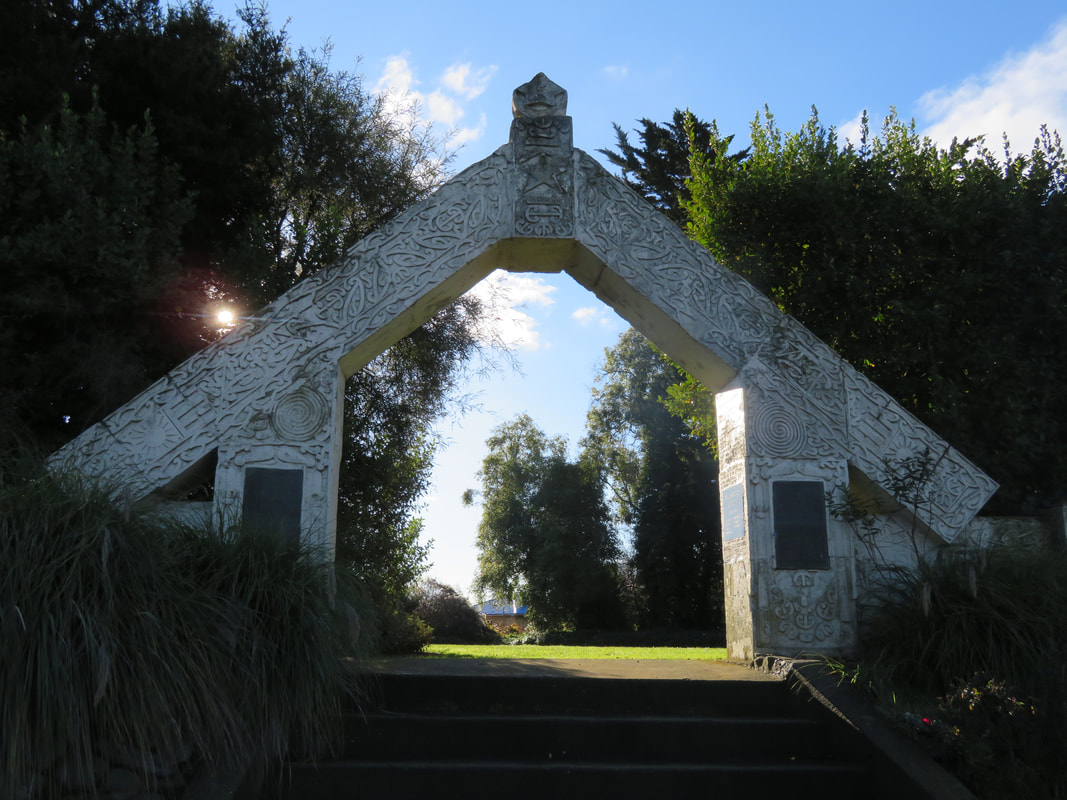|
Something I see flash by every time I head north into Temuka is the interesting looking cream archway on the Northern corner of Huirapa St and the Timaru-Temuka Highway. On my last trip I decided to stop and check it out. It is known as The Ratana War Memorial and was erected at the entrance to a reserve at Arowhenua by members of the Ratana movement in memory of the South Island Maori who fell in the 1914-1918 war. Several plaques have been added over the years as further memorials. This arched gateway is decorated with moulded motifs and images which are done in the style of a traditional whakaiho carved wooden entranceway. These images and mouldings of the Star of David, mere, taiaha and natural designs associated with the Ratana movement. It consists of a gabled ‘bargeboard’ arch with a carved figure at the apex and short columns on the sides. What makes this example unique however is that it is carved from Oamaru stone rather than wood. Work began with the clearing of the site in early 1934 with the carving work to be done by Maori craftsmen from the North Island. There were a few recorded delays and setbacks on the way to unveiling the gateway. Ratana and his Roopu (party of 68 members) arrived on November 12th for the ceremony but rain delayed events till the following day. On the 13th November 1935 the weather cleared, the Morehu Silver Brass Band played, Ratana delivered his speech, hymns were sung and the gateway was unveiled. I was surprised to see it has no Historic Places Trust listing at this stage. Records are held of the Memorial and Ratana’s speech at the Timaru Library, in the archives Built Heritage Inventory. The arch faces the Holy Trinity Church across Huirapa St and is well worth a look. The carvings, mouldings and inscriptions are weathered but have been painted to help retain their integrity and it is substantially intact. It is quite peaceful given its busy location and the reserve it leads to is a pleasing place to be. It’s a unique and beautiful memorial. Karen Rolleston
0 Comments
Every town seems to have a Scottish Hall tucked neatly away, just off the beaten track. Ours is located at 20 Barnard Street in a central area of town. This handsome solid little hall was designed by the busy local architect Walter Panton & Son and built in 1929 by Andrew Kennedy at an approx. cost of 4000 pounds. It is of red brick and concrete with white cement facings. Features include a tiled entrance vestibule, cornice, pilasters, pediments and brick gable. The flag of St Andrews is proudly inlaid above the windows. Constructed as a concert hall it had an opening stage, a couple of dressing rooms and a kitchen. Nothing to grand or fussy here but it is still aesthetically and architecturally pleasing. Over the years it has provided a venue for social and recreational purposes and still does so today. An interesting aside is that the Timaru Herald, on 15/03/1929, reported that the original roof was of British made asbestos cement, the first time this particular material has been used in Timaru! These relatively unassuming little buildings were a centre of activity in their heyday. Originally they were built by local Scottish society’s to create a cultural centre where the records and traditions of Scottish history could be preserved and where the study of Scottish music, song and literature were promoted. These Society’s aimed to foster Scottish traditions in new settlements and provide people with a chance gather together for conversation and counsel, to wear their Highland costumes and tell tales of the old country. In good condition, it is still used for Housie, music competitions and, as it is not to close to large residential areas, this makes it perfect for the Pipe Band practice venue which I understand happen here occasionally. The Hall is available to hire for events and occasions. Karen Rolleston |
View by date Archives
February 2021
Categories |
|
|





